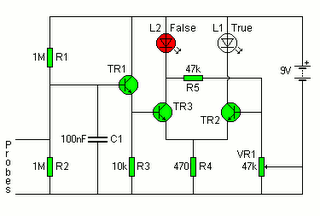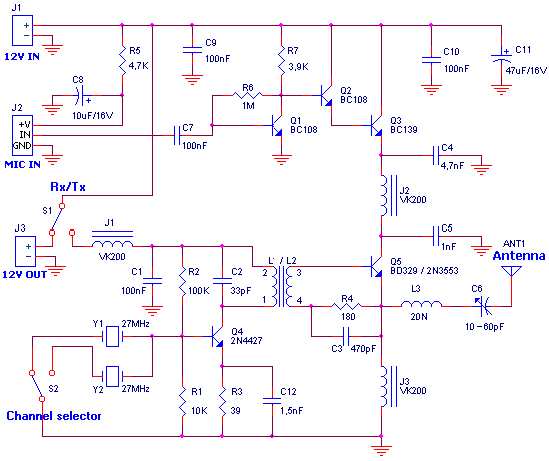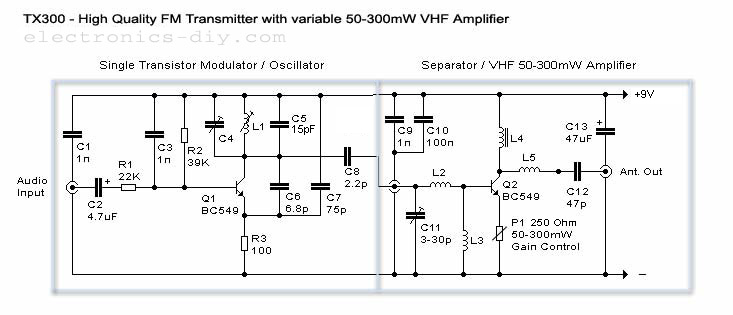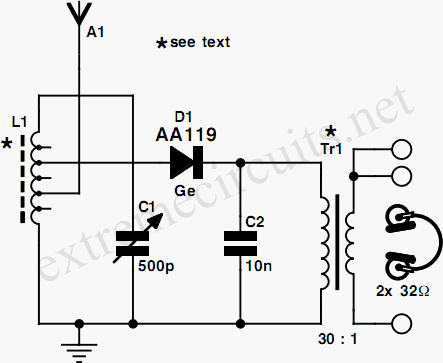
IR headphone transmitter CD4046
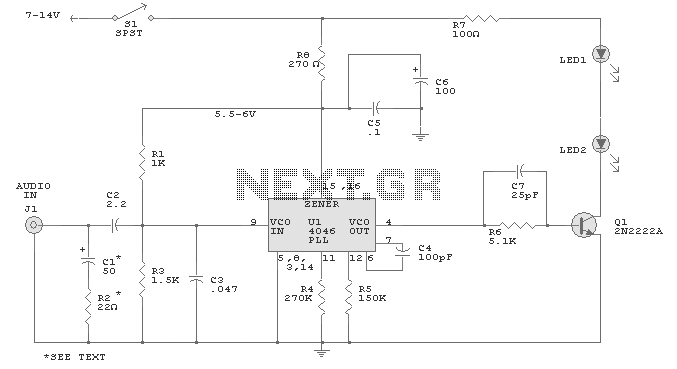
The transmitter for the wireless headphones is built around a CD4046 CMOS phase-locked loop, coupled with a driver transistor, and a pair of infrared LEDs. More: Although the CD4046 is comprised of two phase comparators, a voltage-controlled oscillator (or VCO), a source follower, and a zener reference, only its VCO is used in this application.
The circuit design for the wireless headphone transmitter utilizes the CD4046 CMOS phase-locked loop (PLL) as the core component for generating the necessary frequency signals. The CD4046 is a versatile IC that includes two phase comparators, a voltage-controlled oscillator (VCO), a source follower, and a zener reference, allowing for robust frequency modulation capabilities. In this specific application, the focus is on the VCO, which is responsible for generating a carrier frequency that will be modulated by the audio signal.
The VCO's output frequency can be adjusted by varying the voltage applied to its control input, enabling the transmitter to modulate the audio signal effectively. The audio input is fed into the circuit, where it is combined with the VCO output to create a modulated signal. This modulated signal is then amplified using a driver transistor, which increases the power level to drive the infrared LEDs.
The choice of infrared LEDs is significant, as they provide a means for wireless transmission of the audio signal. The modulated output from the driver transistor is connected to the infrared LEDs, which emit the modulated light signal that can be detected by the corresponding receiver unit in the wireless headphone system. The design ensures that the transmission is efficient and maintains audio fidelity, allowing users to enjoy a high-quality listening experience without the constraints of wired connections.
Overall, the integration of the CD4046 PLL, driver transistor, and infrared LEDs forms a compact and effective transmitter circuit, suitable for wireless headphone applications. This setup capitalizes on the advantages of infrared communication, such as reduced interference and the ability to operate in various environments.The transmitter for the wireless headphones is built around a CD4046 CMOS phase-locked loop, coupled with a driver transistor, and a pair of infrared LEDs. Although the CD4046 is comprised of two phase comparators, a voltage-controlled oscillator (or VCO), a source follower, and a zener reference, only its VCO is used in this application. 🔗 External reference
The circuit design for the wireless headphone transmitter utilizes the CD4046 CMOS phase-locked loop (PLL) as the core component for generating the necessary frequency signals. The CD4046 is a versatile IC that includes two phase comparators, a voltage-controlled oscillator (VCO), a source follower, and a zener reference, allowing for robust frequency modulation capabilities. In this specific application, the focus is on the VCO, which is responsible for generating a carrier frequency that will be modulated by the audio signal.
The VCO's output frequency can be adjusted by varying the voltage applied to its control input, enabling the transmitter to modulate the audio signal effectively. The audio input is fed into the circuit, where it is combined with the VCO output to create a modulated signal. This modulated signal is then amplified using a driver transistor, which increases the power level to drive the infrared LEDs.
The choice of infrared LEDs is significant, as they provide a means for wireless transmission of the audio signal. The modulated output from the driver transistor is connected to the infrared LEDs, which emit the modulated light signal that can be detected by the corresponding receiver unit in the wireless headphone system. The design ensures that the transmission is efficient and maintains audio fidelity, allowing users to enjoy a high-quality listening experience without the constraints of wired connections.
Overall, the integration of the CD4046 PLL, driver transistor, and infrared LEDs forms a compact and effective transmitter circuit, suitable for wireless headphone applications. This setup capitalizes on the advantages of infrared communication, such as reduced interference and the ability to operate in various environments.The transmitter for the wireless headphones is built around a CD4046 CMOS phase-locked loop, coupled with a driver transistor, and a pair of infrared LEDs. Although the CD4046 is comprised of two phase comparators, a voltage-controlled oscillator (or VCO), a source follower, and a zener reference, only its VCO is used in this application. 🔗 External reference

